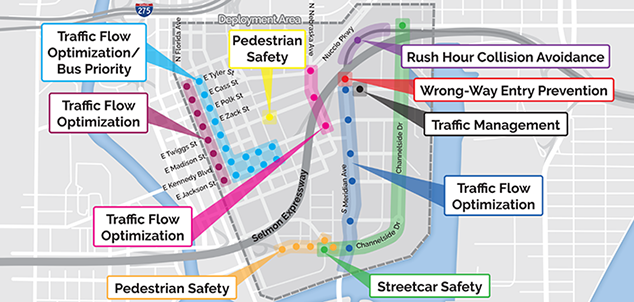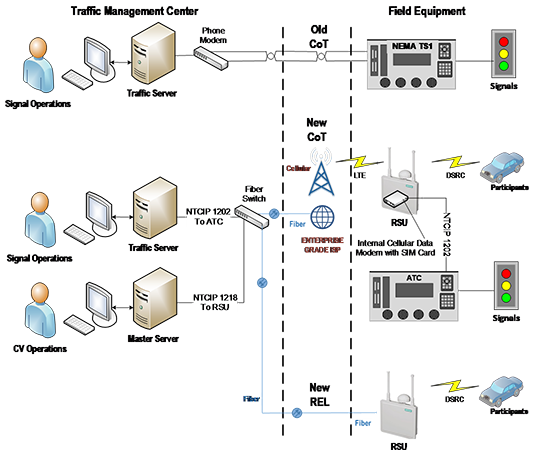Tampa Hillsborough Expressway Authority (THEA), along with New York City Department of Transportation (DOT) and the Wyoming DOT, is implementing multiple Connected Vehicle applications that will help to improve safety, mobility, and reduce environmental impact. The project is partly funded by the U.S. Department of Transportation, and partly by local agencies.
In Tampa, the project involves installing onboard units (OBU) in up to 1,000 vehicles and roadside units (RSU) in 47 locations along THEA’s Reversible Express Lane (REL) and in the Central Business District (CBD) to enable vehicle-to-vehicle (V2V) and vehicle-to-infrastructure (V2I) communications. As shown in Figure 1, there were initially 45 RSUs connected via the cellular network. THEA was able to convert the RSUs on the REL to fiber as there was existing fiber along the REL where the RSUs were deployed. Two other RSUs were deployed at remote locations. One RSU is deployed at the Hillsborough Community College (HCC) Technical Campus to support the installations and repairs of Onboard Units (OBUs) into participant vehicles. The second RSU is deployed at the Hillsborough Area Regional Transit (HART) bus barn to support Over the Air (OTA) firmware and configuration updates to bus OBUs as well as provide Security Credential Management System (SCMS) application certificate updates.

Figure 1. THEA Deployment and RSU Locations.
As part of the planning phase of the project, THEA anticipated connecting the RSUs to THEA’s Traffic Management Center (TMC) via fiber as the City of Tampa (COT) had a planned project to install fiber in the CBD. During the design and installation phase, THEA faced two unexpected challenges with this connection between the signal controllers and the RSUs, and between the RSUs and the TMC:
Because of these two challenges, alternative communications options between the RSU and the TMC were explored. THEA decided to install cellular modems in the RSUs to establish communications between the controllers and the TMC, by adapting the RSU as a cellular data modem connection to an Internet Service Provider (ISP) (see Figure 2). This communication link provided both a connection to the CV Pilot’s Master Computer and to the COT Econolite Centracs Signal Controller System.

Figure 2. New Connections in THEA’s CV Deployment Architecture
After the THEA team analyzed the amount of data they believed could be transmitted, they selected a wireless plan with 5 gigabytes per month at a cost of $35 a month for each RSU. In October 2018, data needs increased due to the increase in the number of OBUs deployed, so the plan was increased to 20 gigabytes at a cost of $100 a month for each RSU. This increased the total cost for the RSUs to $4,500 a month in cellular costs. As an agency, this is a high cost in a long-term. Therefore, THEA is working with the COT to determine when and where fiber could be installed to mitigate the cost.
The Tampa area is prone to major thunderstorms and lightning in most summers. During the summer of 2019, while in the operate and maintain phase, several thunderstorms with intense lighting occurred over the pilot deployment. Although each RSU was grounded to the support structure, the support structure itself did not provide an adequate connection to the ground due to hidden painted surfaces, fastener corrosion and other issues (see RSU Transient Surge Immunity article). During severe storms, several RSU mounting and grounding structures were struck by lightning. Because the grounding was inadequate, the energy took the only remaining path to ground through the RSU Ethernet cable, rendering the RSU inoperable. Each RSU had a SIM card installed for cellular communications, so there was a long process for replacing the damaged RSU with a newly configured RSU. The process was as follows:
This process was inefficient causing a minimum of 5 days of downtime and sometimes up to several weeks. To address this issue, THEA negotiated with Verizon to procure additional SIM cards at no additional cost. The work crew now has access to spare RSUs and SIM cards. This allows damaged RSUs to be replaced in a more efficient manner without sending each RSU to Siemens for SIM card replacement.
THEA eventually resolved these issues and moved to the operations and data collection phase. THEA also documented the issues to hopefully help other potential deployers to include these issues into considerations during planning phases.